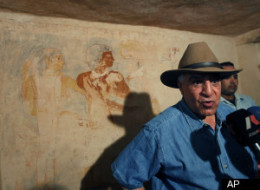 The Associated Press:
The Associated Press: Cairo — Egypt's top archaeologist showed off the newly discovered tomb of a pharaonic priest on Tuesday, a find he said could point the way to a new necropolis to be excavated near the famed Giza pyramids.
Standing inside the 4,300-year-old structure, Zahi Hawass said hieroglyphics on the tomb's walls indicate it belonged to Rudj-ka, a priest inspector in the mortuary cult of the pharaoh Khafre, who built the second largest of Giza's pyramids.
The tomb – about the size of a train car – was adorned with paintings, some of them still vivid. Images on one wall depict a man standing on a boat, spearing fish. Nearby are lotus flowers and different types of birds standing or in flight.
A series of false doors line the opposite wall. A painting above one shows two figures seated opposite each other at an offering table.
The priest, buried with his family, would have supervised those presenting sacrifices to the pharaoh, Hawass said.
"It is very clear that this man was carrying out a very important role," Hawass said, based on the tomb's decoration.
The tomb dates to the 5th Dynasty, 2465-2323 B.C. The pharaoh Khafre died earlier, around 2494 B.C., but pharaohs were often worshipped after death, Hawass said.
The tomb remains in good condition, Hawass added, though it had been previously broken into and looted, perhaps in the 19th century.
Archaeologists discovered it about a month ago and have been excavating it since.
Hawass said it would not be open to the public, though some visitors could get permits to see it.
Standing atop a dune near the tomb's entrance, Hawass said it was the first tomb discovered to the west of Khafre's pyramid and could lead to more discoveries nearby.
"The sand of Egypt hides lots of secrets," he said.
No comments:
Post a Comment
Note: Only a member of this blog may post a comment.